Regarded as one of the best Bonsai trees for beginners, the ficus Bonsai tree is made to thrive in an indoor environment. With waxy leaves and easily trained branches, most ficus plants are perfect for the beginning Bonsai tree artist. But how does the care of a ficus Bonsai tree differ from other types of Bonsai trees? What do you need to know before you start caring for one?
We’ll go over some of the most common types of ficus plants to use in a Bonsai tree format as well as the general care requirements for these tiny trees. From sunlight requirements to some stylistic ideas, here’s how to craft and care for a ficus Bonsai tree!

Some of the easiest Bonsai trees to care for are ficuses.
©iStock.com/RenataKa
| Ficus Bonsai Tree Care | |
|---|---|
| Botanical Name | Moraceae |
| Common Types | Ficus ginseng, Ficus religiosa, Ficus microcarpa, Ficus benjamina, willow leaf Ficus, tiger bark ficus |
| Sunlight | Full, direct sun, preferably south-facing, or grow lights |
| Soil | Bonsai soil mix, pumice, lava rock, akadama, organic indoor potting soil |
| Water | Room-temperature water, preferably distilled; water when soil is drying out and mist daily |
| For Beginners? | Yes! The most forgiving Bonsai tree type for beginning artists |
| Indoors or Outdoors? | Indoors only; cannot handle frosty conditions |
| Pairs Well With… | Aerial root design, other types of ficus Bonsai trees |
Common Types of Ficus Bonsai Trees
Members of the mulberry or fig family, ficus plants are often referred to as figs. There are over 800 different types of ficus species, but not all of them are suited to Bonsai crafting. However, there are plenty of types that are! This is especially true when you consider the fact that ficus plants are some of the most popular and common Bonsai trees, particularly for growing indoors.
Let’s take a closer look at some common types of ficus plants used in the art of Bonsai cultivation.
Ficus Ginseng
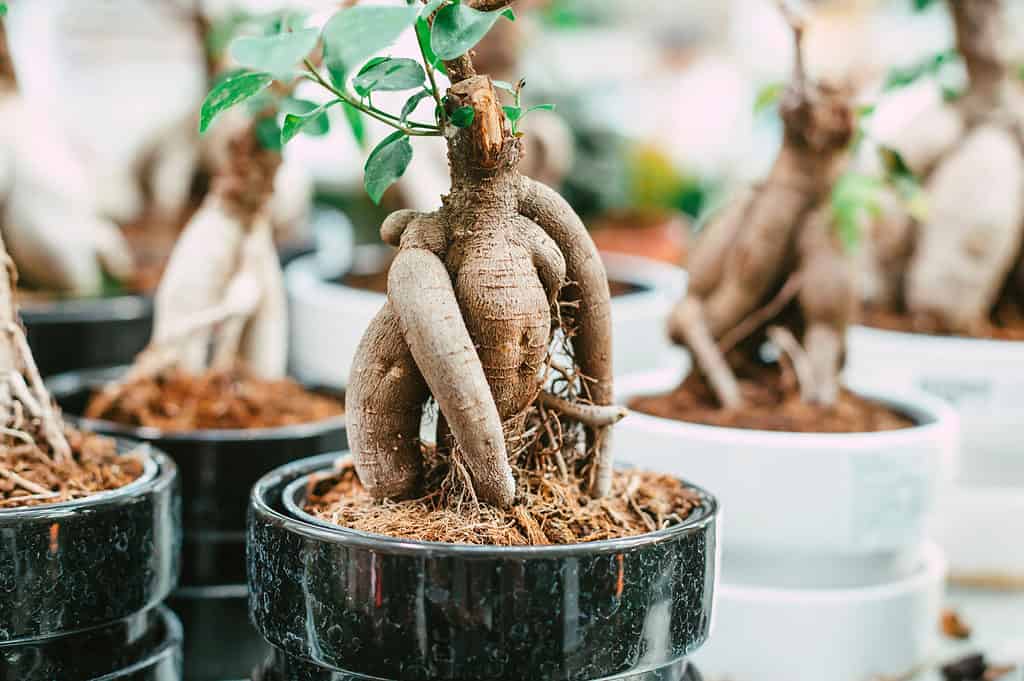
With a large base, the ficus ginseng is a striking Bonsai tree.
©Bulgn/Shutterstock.com
Prized for its distinctly swollen trunk, the ficus ginseng variety of ficus is technically a ficus microcarpa cultivar. However, this particular cultivar has a beautifully thick trunk, making it ideal for Bonsai cultivation and design. Plus, this ficus species grows fairly quickly and is easy to care for, making it a striking and simple option for the beginning artist. Keep in mind that the leaves from just about any ficus species are poisonous to cats and dogs!
Ficus Microcarpa

Popular for its ease of care, the ficus microcarpa Bonsai tree produces unique aerial roots.
©windmoon/Shutterstock.com
Also known as a banyan Bonsai tree, ficus microcarpa plants are the most common ficus used in Bonsai cultivation. These ficus varieties are nearly identical in care to the ficus ginseng, but their trunks are not as swollen or thick. However, the ficus microcarpa variety is great for crafting aerial roots and intricate designs, especially for the creative beginner!
Ficus Religiosa
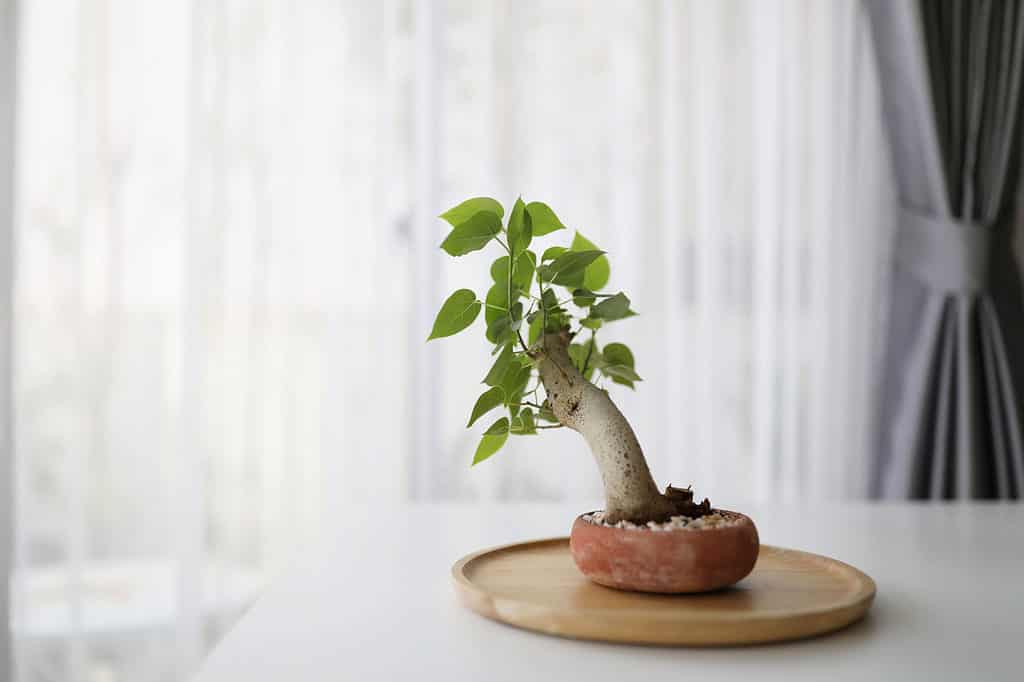
Most ficus religiosa Bonsai trees love high humidity levels.
©Paladin12/Shutterstock.com
With heart-shaped leaves and a fast-growth habit, ficus religiosa Bonsai trees are a lesser-known ficus Bonsai variety. However, it’s still a great option to consider for its ease of care and shaping possibilities! Ficus religiosa Bonsai specimens may also be known as sacred fig trees or Bodhi trees.
Ficus Benjamina
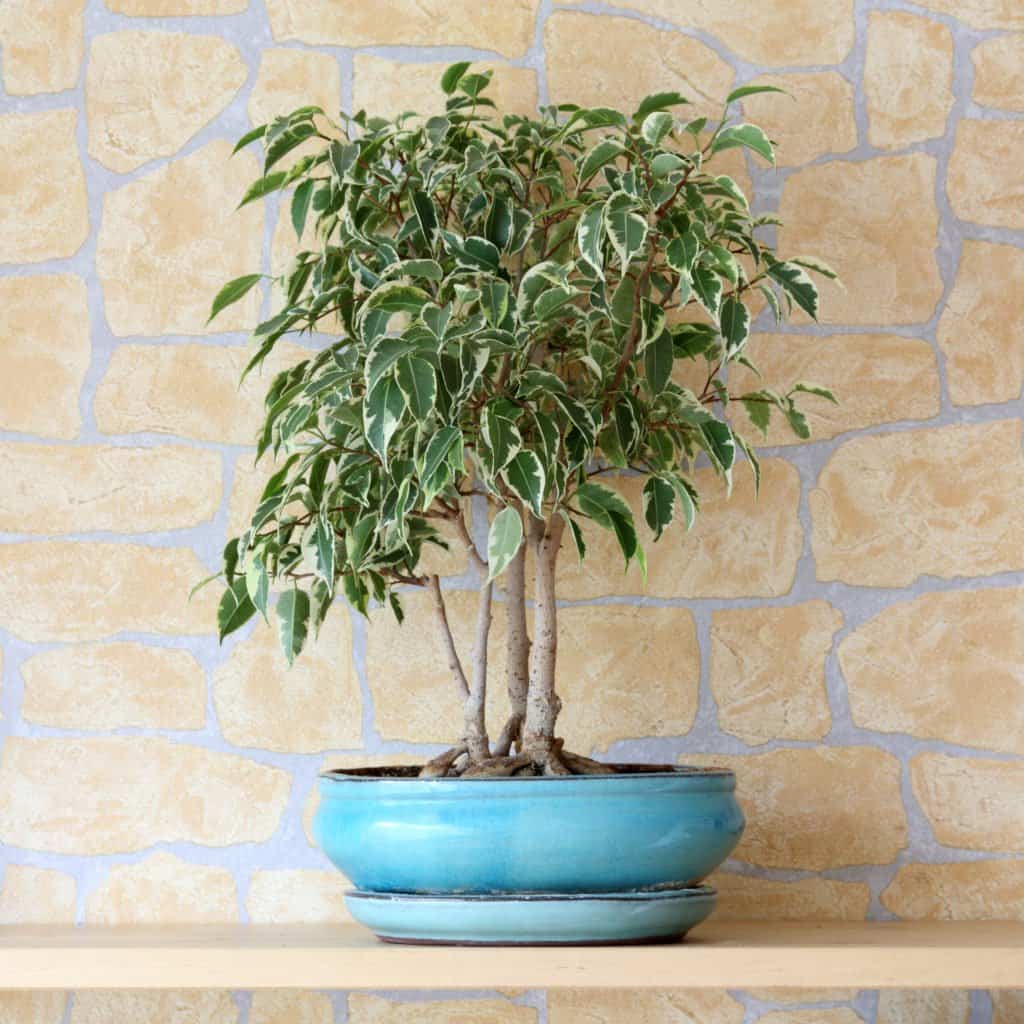
©loflo69/Shutterstock.com
Another fast-growing ficus variety has to be ficus benajmina. When grown in a Bonsai tree format, ficus benjamina plants produce small leaves and are easy to wire or shape indoors. These plants also produce small flowers, depending on the level of care it receives. Plus, you can also have fun designing the aerial roots on this tree!
Willow Leaf Ficus

With narrow leaves, willow leaf ficus Bonsai trees are delicate and coveted.
©Khairil Azhar Junos/Shutterstock.com
If you like the look of willow Bonsai trees but don’t want to risk taking care of a more complicated plant, then the willow leaf ficus may be perfect for you. Also known as ficus nerifolia, willow leaf ficus Bonsai trees produce branches and foliage that weep like a traditional willow tree. The leaves are narrow and easy to prune, making this one of the more unique ficus varieties.
Tiger Bark Ficus
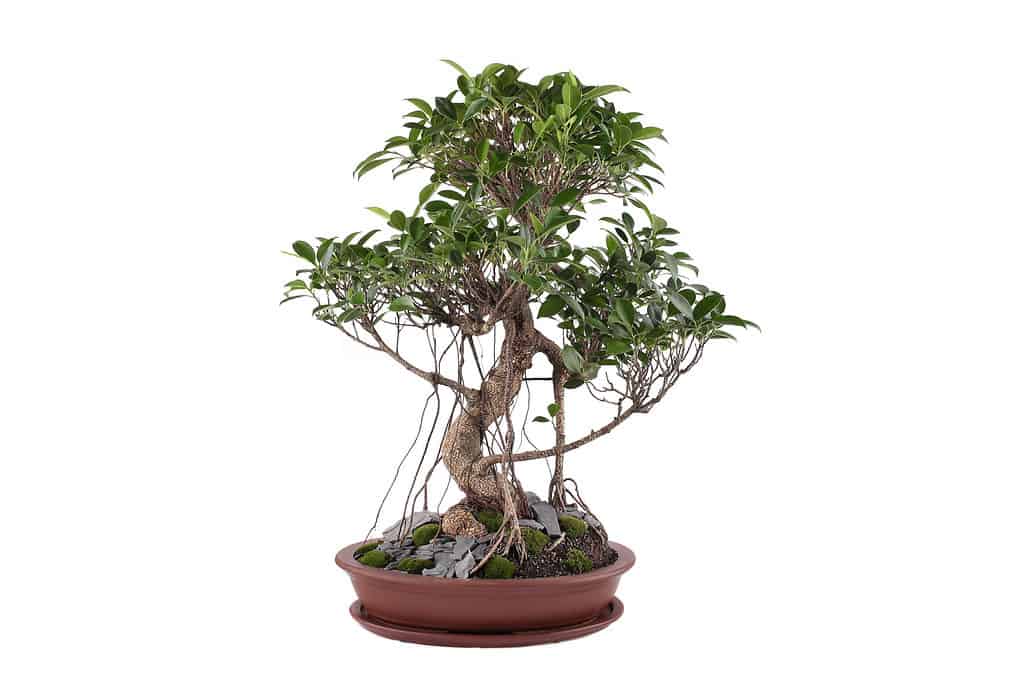
tiger bark ficus bonsai tree
©gielmichal/Shutterstock.com
Commercially sold around the world, the tiger bark ficus Bonsai tree goes by a few names. You may know this ficus variety as the Golden Gate ficus as well. This particular ficus microcarpa cultivar grows similarly to its ficus tree peers, easy to care for and maintain. But it produces a striped and spotted bark that gives it its name and makes it more eye-catching!
Caring for Your Ficus Bonsai Tree
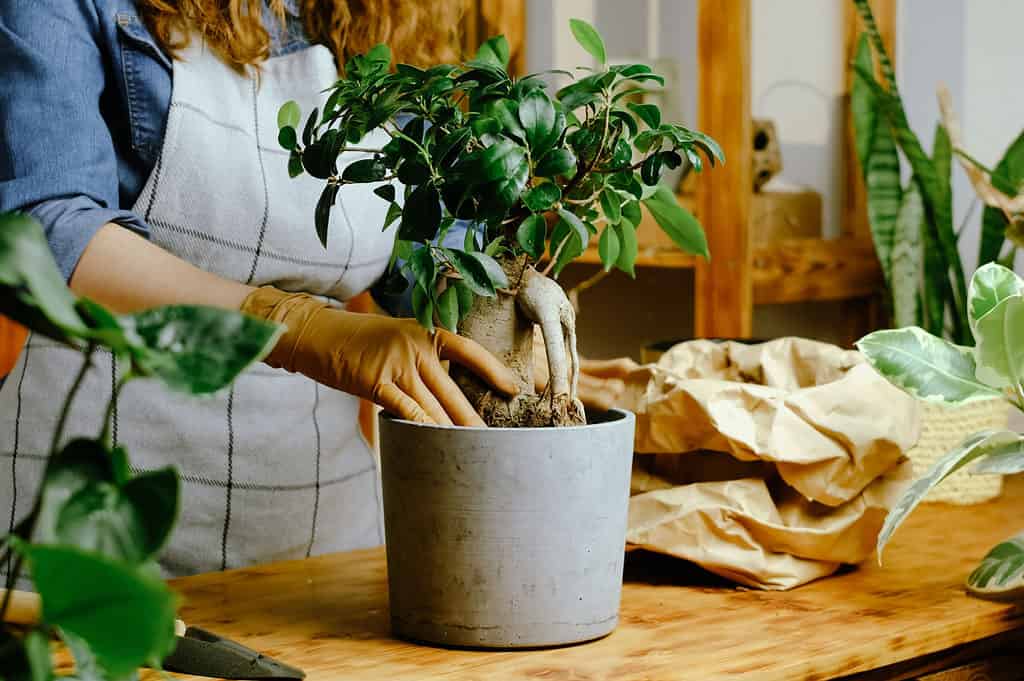
Your ficus bonsai tree likely needs repotting every couple of years.
©Meteoritka/Shutterstock.com
Given the fact that ficus plants are one of the most popularly cultivated plants for Bonsai purposes, you may be wondering about the care requirements of them. While they are ideal for beginners, ficus Bonsai trees still need a precise and measured level of care. Here are some guidelines for how to care for your ficus when grown in a Bonsai tree format.
Sunlight
Ficus plants require a high level of sunlight in order to thrive, even when grown indoors. You should place your ficus Bonsai tree in direct sunlight, in a location that receives at least six hours of light per day. Be sure not to set your ficus too close to a window or doorway, as drafts or cold temperatures can deeply affect its growth.
Soil Type
The soil used for a ficus Bonsai tree shouldn’t differ from any other type of Bonsai tree. However, you may be able to get away with organic indoor potting soil mixed with other soil types to help your ficus Bonsai tree thrive. Many Bonsai soil mixes utilize lava rocks, pumice, and a type of clay known as akadama. You can make your own soil mixture or simply purchase a premade option for your ficus.
Water
All Bonsai trees need to be watered with care, even though your ficus will be more forgiving than other tree types. Make sure to water your ficus Bonsai tree with room temperature water whenever it begins to dry out. Water it deeply, but allowing it to dry out is often helpful for its growth. Distilled water is also helpful when growing any indoor Bonsai tree, as this helps prevent diseases or bacteria from spreading to your plants from tap water.
Something to also consider about growing a ficus Bonsai tree is the fact that humidity is important for its overall growth. This is especially true if you want your ficus to produce aerial roots or flowers. You may consider keeping your Bonsai tree in a dome or other covering so that humidity and moisture are encouraged. 100% humidity is one of the only ways for you to get aerial roots on an indoor-grown ficus Bonsai tree.
Placement
As previously mentioned, you should place your ficus in an area that receives plenty of sunlight. A south-facing placement is highly recommended for most indoor growing Bonsai trees if possible. For a nice change of pace, you can set your ficus Bonsai tree outdoors during the summertime. So long as temperatures remain above 60 to 70 degrees Fahrenheit, your ficus can take an outdoor vacation!
Ficus plants are more adaptable compared to other Bonsai tree varieties when it comes to being moved, but you should try and maintain a single location for your plant if at all possible!
Pruning Your Ficus Bonsai Tree
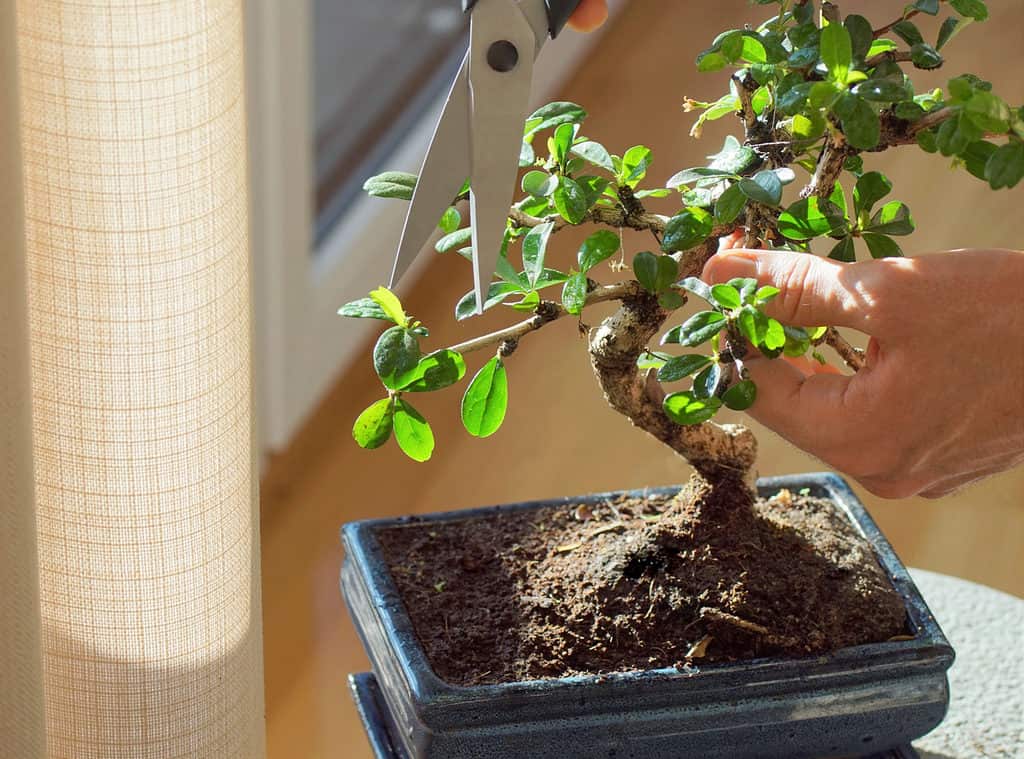
Given just how easy this particular Bonsai tree is to style, ficus plants can be crafted into just about any shape.
©TG23/Shutterstock.com
All Ficus Bonsai trees need to be pruned regularly in order to thrive as well as maintain their miniature shape. However, there are many ways to accomplish this and many methods that still result in success with this particular plant. For example, you can leave your plant alone and allow the trunk to thicken up over time if you want a more stable center.
If you want to maintain a small leaf size, defoliation or consistent pruning of your ficus may be necessary. However, excess pruning will not damage this particular Bonsai tree type as ficus plants readily grow more shoots from pruned locations. The quick-growing nature of most ficus tree species also allows you some flexibility in when and where you prune.
Finally, all ficus tree varieties are relatively easy to wire and shape given their flexible wood and quick growth. However, try not to wire your tree during the summertime, as growth tends to be too fast. This results in the wire cutting into the bark of your ficus Bonsai tree, leading to damage and a weakened specimen overall!
Ideal Ficus Bonsai Tree Styles
Given just how easy this particular Bonsai tree is to style, ficus plants can be crafted into just about any shape. An informal upright style is fairly easy to accomplish, as well as a two or multiple-trunked style design. Many Bonsai artists combine ficus plants with rocks to form unique elements as well as to show off the aerial roots of their specimens. No matter what style you choose, it’s fairly easy to tame your ficus Bonsai tree!
Propagating Your Ficus Bonsai Tree
Another reason you might opt for a ficus Bonsai tree as your first Bonsai tree specimen is because it is extremely easy to propagate. You can create your own ficus Bonsai tree out of any ficus tree cuttings. These cuttings are ideally taken during the summertime when growth is at its maximum. Simply place the cuttings into the soil and give it time to root!
You can also place multiple cuttings in a single container and bind them together to form a larger, more intricate plant. Ficus plants are easy to leave and grow into one singular structure, giving you even more creative freedom to craft the Bonsai tree of your dreams!
Common Problems with Ficus Bonsai Trees

Many tropical house plants, including ficus plants, suffer during cold months.
©Tomasz Klejdysz/Shutterstock.com
While ficus plants are fairly resistant to a number of common problems and pests, any indoor-grown plants will struggle more than their outdoor-grown counterparts. This is especially true with Bonsai trees, as mimicking the natural habitat of a ficus plant is incredibly difficult in the average home. One of the main things to consider when growing a ficus Bonsai tree is its winter care.
Many tropical houseplants, including ficus plants, suffer during cold months. Cold temperatures and dry heat make it difficult to maintain equilibrium for any indoor plant, particularly Bonsai trees that have very little room for nutrient storage. You may find that your ficus Bonsai tree drops its leaves in the wintertime, likely meaning that it needs more light or warmer temperatures.
If you noticed that your ficus Bonsai tree is unhappy, you may need to consider moving it or providing alternative light sources. A weakened Bonsai tree is more susceptible to pests and diseases see, even the resilient ficus. Some common pests that may interact with your ficus tree include:
- Scale
- Soil mold
- Spider mites
- Other insect infestations
If you want to try your hand at Bonsai tree care, a ficus is a great place to begin! Propagating and cultivating a ficus Bonsai tree is rewarding and relatively simple, especially if you want an indoor plant to brighten your living space.
The photo featured at the top of this post is © gielmichal/Shutterstock.com
Thank you for reading! Have some feedback for us? Contact the AZ Animals editorial team.






